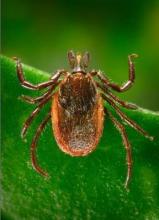A new species of Borrelia has been linked to a variant of Lyme disease with symptoms that differ somewhat from typical Lyme borreliosis.
Of 100,545 routine clinical specimens tested at the Mayo Clinic in Rochester, Minn., for Lyme borreliosis between 2003 and 2014, six clinical specimens – all from 2012 or later – yielded an atypical oppA1 PCR result, according to a study published in Lancet Infectious Diseases.
In patients with specimens yielding atypical results, medical records were reviewed and additional samples were examined by a research team led by Dr. Bobbi Pritt of Mayo Clinic.
The researchers performed DNA sequencing, microscopy, or culturing of the diagnostic specimens (five blood and one synovial), as well as oppA1 PCR testing of Ixodes scapularis ticks (black-legged or “deer” ticks) from regions of suspected patient tick exposure. Among the five blood specimens tested, the median oppA1 copy number was 180 times higher than that found in 13 specimens testing positive for B. burgdorferi during the same time period.
Multigene sequencing identified the spirochete as a novel B. burgdorferi genospecies – the same genospecies detected in ticks collected at a probable patient exposure site.
The newly discovered bacteria, provisionally named Borrelia mayonii, caused Lyme disease with symptoms similar to those caused by B. burgdorferi, but with some distinct clinical features. Similar to classic Lyme disease, fever, headache, rash, and neck pain were experienced in the early stages of infection (days after exposure) and arthritis in the later stages (weeks after exposure). But patients infected with B. mayonii also presented with nausea and vomiting, diffuse rashes (as opposed to the typical “bull’s-eye” rash), and a higher concentration of bacteria in the blood.
“In view of the differing clinical manifestations for patients infected with the novel B. burgdorferi sensu lato genospecies, it is likely that Lyme borreliosis is not being considered – and therefore not diagnosed – in some patients with this infection,” said Dr. Pritt and her colleagues. They added that the clinical range of illness must be better defined in additional patients to ensure the infection is recognized and distinguished from other tick-borne infections, and oppA1 PCR is used for diagnosing infection with B. mayonii.
Read the full study in Lancet Infectious Diseases (doi: 10.1016/S1473-3099[15]00464-8).
On Twitter @richpizzi


